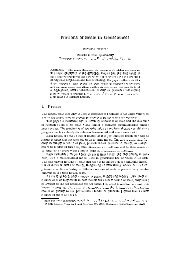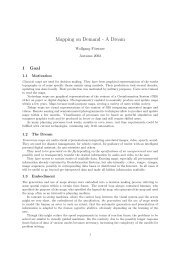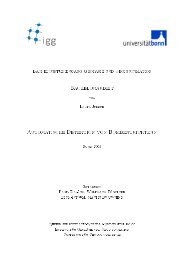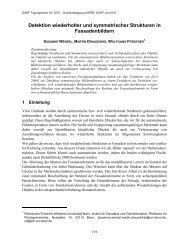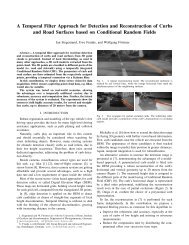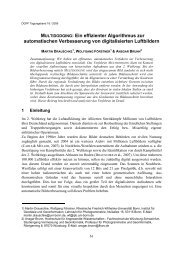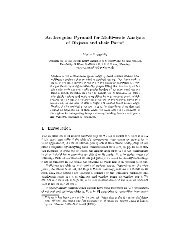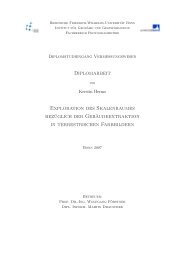Automatic Dodging of Aerial Images - Institut für Photogrammetrie
Automatic Dodging of Aerial Images - Institut für Photogrammetrie
Automatic Dodging of Aerial Images - Institut für Photogrammetrie
Create successful ePaper yourself
Turn your PDF publications into a flip-book with our unique Google optimized e-Paper software.
DGPF Tagungsband 16 / 2007 – Dreiländertagung SGPBF, DGPF und OVG<br />
<strong>Automatic</strong> <strong>Dodging</strong> <strong>of</strong> <strong>Aerial</strong> <strong>Images</strong><br />
MARTIN DRAUSCHKE 1 , ANSGAR BRUNN 2 , KAI KULSCHEWSKI 3 , WOLFGANG FÖRSTNER 1<br />
Abstract: We present an automated approach for the dodging <strong>of</strong> images, with which we edit<br />
digital images as it is usually done with analogue images in dark-rooms.<br />
Millions <strong>of</strong> aerial images <strong>of</strong> all battle fields were taken during the Second World War. They<br />
were intensively used, e.g. for the observation <strong>of</strong> military movements, the documentation <strong>of</strong><br />
success and failure <strong>of</strong> military operations and further planning. Today, the information <strong>of</strong><br />
these images supports the removal <strong>of</strong> explosives <strong>of</strong> the Second World War and the identification<br />
<strong>of</strong> dangerous waste in the soil. In North Rhine-Westphalia, approximately 300.000<br />
aerial images are scanned to handle the huge amount <strong>of</strong> available data efficiently. The<br />
scanning is done with a gray value depth <strong>of</strong> 12 bits and a pixel size <strong>of</strong> 21 μm to gain both, a<br />
high radiometric and a high geometric resolution <strong>of</strong> the images. Due to the photographic<br />
process used in the 1930s and 1940s and several reproductions, the digitized images are<br />
exposed locally very differently. Therefore, the images shall be improved by automated<br />
dodging.<br />
Global approaches mostly returned unsatisfying results. Therefore, we present a new<br />
approach, which is based on local histogram equalization. Other methods as spreading the<br />
histogram or linear transformations <strong>of</strong> the histogram manipulate the images either too much<br />
or not enough. For the implementation <strong>of</strong> our approach, we focus not only on the quality <strong>of</strong><br />
the resulting images, but also on robustness and performance <strong>of</strong> the algorithm. Thus, the<br />
technique can also be used for other applications concerning image improvements.<br />
1 Introduction<br />
1.1 Allied images for the disposal <strong>of</strong> explosives <strong>of</strong> the Second World War<br />
Millions <strong>of</strong> aerial images <strong>of</strong> all battle fields were taken during the Second World War (WWII).<br />
Especially Great Britain already started taking photographs <strong>of</strong> parts <strong>of</strong> Germany even before the<br />
beginning <strong>of</strong> the Second World War. During the war the organization <strong>of</strong> the aerial<br />
reconnaissance was constantly improved (Babington Smith, 2004). The number <strong>of</strong> images<br />
increased rapidly (LUA NRW, 2006).<br />
The aerial images were intensively used, e.g. for the observation <strong>of</strong> military movements, the<br />
documentation <strong>of</strong> success and failure <strong>of</strong> military operations or the planning <strong>of</strong> further strategies.<br />
The films were developed in the field immediately after landing. A courier delivered them to the<br />
1<br />
Department <strong>of</strong> Photogrammetry, <strong>Institut</strong>e <strong>of</strong> Geodesy and Geoinformation, University <strong>of</strong> Bonn,<br />
Nussallee 15, 53115 Bonn, martin.drauschke@uni-bonn.de, wf@ipb.uni-bonn.de<br />
2<br />
Kampfmittelbeseitigungsdienst Westfalen-Lippe, Bezirksregierung Arnsberg, In der Krone 31, 58099<br />
Hagen, ansgar.brunn@bezreg-arnsberg.nrw.de<br />
3<br />
Kampfmittelbeseitigungsdienst Rheinland, Bezirksregierung Düsseldorf, Färberstraße 136, 40223<br />
Düsseldorf, kai.kulschewski@bezreg-duesseldorf.nrw.de<br />
173
DGPF Tagungsband 16 / 2007 – Dreiländertagung SGPBF, DGPF und OVG<br />
headquarters, <strong>of</strong>ten only a few hours after the landing <strong>of</strong> the reconnaissance plane (Stanley,<br />
1981).<br />
Today, these images support the removal <strong>of</strong> explosives <strong>of</strong> the Second World War or the<br />
identification <strong>of</strong> dangerous waste in the soil. North Rhine-Westphalia (NRW) has two bomb<br />
disposal services which identify, detect, remove and destroy not yet exploded bombs and other<br />
munitions. The first step <strong>of</strong> the removal <strong>of</strong> bombs is image interpretation. The services archive<br />
almost 300,000 allied images. The photo interpreter and geodesists identify in these images<br />
bombed areas, signatures <strong>of</strong> unexploded bombs and <strong>of</strong> military infrastructure and reference this<br />
data. Detection and removal units complete the job in the field.<br />
1.2 Digitization <strong>of</strong> the archive <strong>of</strong> analog allied images<br />
Up to now analogue photo copies have been used for the image interpretation. The image<br />
interpretation task is done separately for each site. For each multi-temporal image interpretation<br />
from 10 up to several hundreds <strong>of</strong> images have to be analyzed. Therefore the explosive disposal<br />
units put a high effort in managing the analogue archives at the moment. This effort will increase<br />
when additional images will be available from recently opened archives (Carls & Müller, 2007).<br />
In the future only digital images will be used. All sites will be interpreted from digital images.<br />
Therefore all images have to be digitized with high accuracy resulting from high demands <strong>of</strong><br />
interpretation quality for the bomb disposal task, i.e. a high radiometric contrast to identify small<br />
holes in the bare soil which result from the penetration <strong>of</strong> the unexploded bombs, and a high<br />
geometric accuracy to get precise coordinates <strong>of</strong> possible places <strong>of</strong> unexploded bombs.<br />
In addition to the demands resulting from the task <strong>of</strong> bomb disposal, additional demands result<br />
from economical aspects: no human interaction should be needed for the scanning <strong>of</strong> each image<br />
nor for the improvement <strong>of</strong> the scanned images. These efforts point out that a high degree <strong>of</strong><br />
automation <strong>of</strong> the process is needed. The large amount <strong>of</strong> images makes a priori investigations<br />
sensible and economical interesting.<br />
1.3 Overview <strong>of</strong> the rest <strong>of</strong> the paper<br />
In the following we will describe the scanning process. In chapter 3 we will report on several<br />
tests <strong>of</strong> image improvement methods which use intuitive and commercially available algorithms.<br />
Afterwards in chapter 4 we will present results and demonstrate some properties. This paper<br />
closes with a short summary and an outlook on the further work which has to be done in the<br />
scanning project.<br />
2 Automated scanning <strong>of</strong> allied images <strong>of</strong> the WWII<br />
2.1 Scanning overview<br />
In the 1990s Germany got access to images from the British archive <strong>of</strong> allied aerial images,<br />
which nowadays is hosted at TARA 4 . Back then hundreds <strong>of</strong> boxes with cut aerial images were<br />
brought to Germany. Each <strong>of</strong> the borrowed images is a copy in an unknown series <strong>of</strong> copies <strong>of</strong><br />
4<br />
The <strong>Aerial</strong> Reconnaissance Archives (TARA) at Keele University, www.evidenceincamera.co.uk,<br />
last visit: 1.5.2007<br />
174
DGPF Tagungsband 16 / 2007 – Dreiländertagung SGPBF, DGPF und OVG<br />
the original photographs. These copies survived somehow the confusion during and after WWII.<br />
These images were reproduced on film rolls and were archived in Germany again. Since then,<br />
they have been used to generate analogue photos for manual image interpretation <strong>of</strong> the bomb<br />
disposal units for the last 15 years. During the photographic reproduction process on paper a<br />
line-based photographic dodging was performed in a dark-room. The exposure time was<br />
calculated from the brightness <strong>of</strong> each reproduced image line.<br />
For the scanning project the existence <strong>of</strong> the film rolls is a big benefit, because the rolls allow<br />
automatic scanning by a photogrammetric scanner. We use a unique label found on each image<br />
to identify each image on the film roll and scan the images with 21µm resolution in 12 bits.<br />
Although the image is scanned with 12 bits, storage <strong>of</strong> the data follows in 16 bits. To avoid timeconsuming<br />
and individual scan settings for each film and each image resp., only one set <strong>of</strong><br />
parameters is used during the scan process for efficient scanning. That is why in most cases the<br />
overall image quality <strong>of</strong> the original scans is inadequate. Figure 1 gives an impression <strong>of</strong> the<br />
quality <strong>of</strong> the majority <strong>of</strong> the scanned images.<br />
This scanning result does obviously not allow a reliable interpretation. Thus, an algorithm for<br />
image improvement has to be found. The following demands have to be satisfied by the resulting<br />
images:<br />
• They need to be interpretable by specialists in allied image interpretation.<br />
• They should have a nice look because they should allow a quick overview on bomb<br />
penetration and waste pollution.<br />
• They have to reveal small structures like small holes in the ground <strong>of</strong> blinders.<br />
• The algorithm has to adapt to the failures <strong>of</strong> the available images.<br />
• It has to keep the geometry <strong>of</strong> the image.<br />
• It has to be as fast as the scanning <strong>of</strong> the image.<br />
2.2 Scanning in detail and quality management <strong>of</strong> the scanned images<br />
The aim <strong>of</strong> scanning is to optimize the information content, as well as the histogram, but not the<br />
optimization <strong>of</strong> the visual impression. Additionally, all radiometric properties <strong>of</strong> the analog<br />
images which are supposed to be scanned need to be reproduced in the digital images as good as<br />
possible. The complete reprographic range <strong>of</strong> each image is to be scanned during the scanning<br />
process.<br />
In order to optimize the image information content, all digital images must fulfill the following<br />
general conditions: There must be no irregular swaths / scan lines and stains in the digital image,<br />
and the radiometric contrasts in the dark (shadows) and in the light image areas (clouds, snow,<br />
overexposed areas), which can be seen in the original image, must also exist in the scanned<br />
image.<br />
Furthermore, the radiometric resolution <strong>of</strong> 16 bits must effectively be utilized. In addition the<br />
histogram <strong>of</strong> a so called inner range has to fulfill certain conditions. The inner range only<br />
175
DGPF Tagungsband 16 / 2007 – Dreiländertagung SGPBF, DGPF und OVG<br />
contains objects which were captured during the original exposure. No superimposed fiducial<br />
marks nor any text are allowed to exist in the inner range.<br />
The inner range has no constant <strong>of</strong>fset to the unique label. In order to avoid complex individual<br />
detection <strong>of</strong> the inner range <strong>of</strong> each image, the inner range can be defined, so that the distance<br />
from the original image area on all four sides, does not exceed the value <strong>of</strong> 1,5cm.<br />
For the optimization <strong>of</strong> the image information the guideline <strong>of</strong><br />
the scanning contains the following items:<br />
• The histogram <strong>of</strong> the whole scanned image has to<br />
range from 6553 to 58983. Within this range the<br />
minimum <strong>of</strong> 245 grey values must possess a frequency<br />
greater than 0,01% <strong>of</strong> the number <strong>of</strong> pixels in the inner<br />
range,<br />
• Maximally 0,01 % <strong>of</strong> all grey values in the inner range<br />
are allowed to exceed the grey value from 1 to 6553,<br />
and the grey value from 58983 to 65535.<br />
• The grey values 0 and 65536 are not permitted.<br />
Figure 1. Input Image<br />
Through the introduction <strong>of</strong> these boundary conditions, a later transformation to 8 bit is<br />
guaranteed, so that all objects <strong>of</strong> a 16 bit image taken during the photo flight are present. They<br />
can then be optimized during radiometric post-processing to avoid underexposures or overexposures<br />
in the 16 bit scanned image. The histogram derived from the 8 bit image is almost complete<br />
and the grey values from the 8 bit image are not derived from extrapolations.<br />
3 Previous Work<br />
Let I be the input image with 0 ≤ I(x,y) ≤ gmax for all pixels (x,y) <strong>of</strong> the image and H its<br />
histogram. Fig. 1 shows a scanned aerial image <strong>of</strong> an area in North Rhine-Westphalia and Fig. 2<br />
its histogram.<br />
The information <strong>of</strong><br />
the input image is<br />
not recognizable for<br />
human eyes, since<br />
over 90% <strong>of</strong> all<br />
pixels have one <strong>of</strong><br />
the 10%-highest grey<br />
values. The scanning<br />
<strong>of</strong> the image has<br />
been adjusted in such<br />
a way, that all<br />
information is<br />
preserved during the<br />
scan process. Thus,<br />
Figure 2. Histogram <strong>of</strong> input image after quantization to 8 bits.<br />
176
DGPF Tagungsband 16 / 2007 – Dreiländertagung SGPBF, DGPF und OVG<br />
the frame <strong>of</strong> the image contains almost all the dark parts <strong>of</strong> the image. The rest <strong>of</strong> the image is<br />
too light for recognizing structures in the photographed landscape manually.<br />
The analysis <strong>of</strong> the histogram <strong>of</strong> such an image shows that many grey values occur in the image,<br />
but most <strong>of</strong> them not more than only a few times. There is a number <strong>of</strong> small peaks in the middle<br />
<strong>of</strong> the histogram most <strong>of</strong> which result from the grey values <strong>of</strong> the image frame. The maximum in<br />
the histogram is located near the highest possible grey value gmax.<br />
Finally, we denote the output image with O(x,y).<br />
3.1 Inner-range dodging with local histogram spreading<br />
In a first approach, we use histogram spreading for improving the visibility in the images.<br />
Therefore, it is necessary to select an inner-range <strong>of</strong> an image to exclude the frame around the<br />
scene in the aerial image. The inner range has to be defined interactively due to writings on the<br />
a b<br />
c d<br />
Figure 3. <strong>Dodging</strong> with histogram spreading. Part (a) shows the global approach, parts (b-d)<br />
show the results <strong>of</strong> an inner-range dodging with variable patch sizes. Therefore, we divided<br />
the image into 4 patches (b), 100 patches (c) or 400 patches (d) <strong>of</strong> equal size.<br />
177
DGPF Tagungsband 16 / 2007 – Dreiländertagung SGPBF, DGPF und OVG<br />
image and failures <strong>of</strong> image parts, also to exclude clouds, dust or reflection <strong>of</strong> sunlight. The inner<br />
range is divided into disjoint patches. For each patch, we determine the minimum and maximum<br />
gray values. Then we spread the histogram up to fixed anchor points, in which we define for 16<br />
bit images with 65536 possible gray values 2560 as the minimum anchor point, and 62720 as the<br />
maximum. Disturbances in the image are not handled separately, thus many results show<br />
extreme discomposure. Fig. 3 shows the visibility improvements using the inner range dodging<br />
in four cases.<br />
3.2 Multidodging with local mean-shift<br />
Figure 4. Output image <strong>of</strong><br />
multidodging approach.<br />
D(<br />
x,<br />
y)<br />
O x,<br />
y)<br />
= p1<br />
σ ( x,<br />
y)<br />
( + p<br />
We check all transformed pixel, if they are out<br />
<strong>of</strong> bounds, that means either D’(x,y) < 0 or<br />
D’(x,y) > gmax. The rate <strong>of</strong> all pixels which we<br />
have to correct afterwards, is low (around 3%),<br />
since we chose as parameters p1 = 20,000 and<br />
p2 = 25,000 for ingoing 16-bit-images.<br />
The result <strong>of</strong> this approach is a strongly<br />
binarized image as shown in fig. 4. Its<br />
histogram consists <strong>of</strong> two peaks as<br />
demonstrated in fig 5.<br />
D<br />
The next approach manipulates the image using a transformation<br />
based on local parameters. Therefore, we call this<br />
method multi-dodging with mean-shift.<br />
In a first step, we smooth the input image I1(x,y) using Gaußfilters<br />
with a very large smoothing kernel, e.g. σ = 51. Then,<br />
we determine a difference image D(x,y) , which contains the<br />
absolute grey value differences between the original and the<br />
smoothed image, and we also determine a variance image<br />
σD(x,y), where we store the squares <strong>of</strong> the difference.<br />
In the second step <strong>of</strong> this method, we transform the grey<br />
values <strong>of</strong> the image by a linear transformation. The<br />
difference image D(x,y) is a good approximation <strong>of</strong> the local<br />
mean, thus we may transform the input image by the<br />
following linear function, where we adjust the image towards<br />
a constant mean and a constant variance:<br />
2<br />
178<br />
Figure 5. Histogram <strong>of</strong> output image <strong>of</strong><br />
multidodging approach with mean-shift.
DGPF Tagungsband 16 / 2007 – Dreiländertagung SGPBF, DGPF und OVG<br />
4 Results and Properties <strong>of</strong> the New <strong>Dodging</strong> Algorithm<br />
Globally determined histogram equalizations return globally satisfying results. However the<br />
contrast in various image parts is still to low to distinguish small structures successfully.<br />
Consequently, we divide the image into p image patches Pi, with a fixed size for each patch and<br />
p<br />
I ( x,<br />
y)<br />
= U Pi<br />
and Pi ∩ Pj<br />
= ∅,<br />
∀i<br />
≠ j<br />
i=<br />
1<br />
The borders between the image patches are clearly visible after transforming each image patch<br />
by its own histogram equalization Ei. Thus, the returned image cannot be just the union <strong>of</strong> the<br />
transformed image patches.<br />
p<br />
( x,<br />
y)<br />
≠ E ( P ( x,<br />
y))<br />
O U i i<br />
i=<br />
1<br />
Hence, we have to remove the edges between the patches without destroying significant edges<br />
within the image. Furthermore, we strengthen the contrast between equally colored objects and<br />
manipulate the contrast, where it is too strong.<br />
a<br />
c<br />
b<br />
Figure 6. Results <strong>of</strong> the new<br />
dodging algorithm. Part (a) shows<br />
the result <strong>of</strong> the global approach,<br />
where no subdivision in patches<br />
has been done. Part (b) shows the<br />
result with a patch size <strong>of</strong> 1000 x<br />
1500 pixels, and part (c) is its<br />
histogram.<br />
.<br />
We tested the algorithm<br />
on about<br />
20,000 images. The<br />
performance <strong>of</strong> the<br />
algorithm is in the<br />
same range as the<br />
image scanning, it<br />
takes about 3-5<br />
minutes. The radiometric<br />
resolution <strong>of</strong><br />
the input and the output<br />
image may be<br />
chosen to be 8 or 16<br />
bits.<br />
We designed the<br />
program start in a<br />
way that each user<br />
may set the parameters<br />
for the patch<br />
size. Thus, we are able to demonstrate the performance <strong>of</strong> the dodging approach with different<br />
choices for the patch size. If it is chosen as big as the input image’s size, the dodging is done<br />
globally. Alternatively, one may select patches which completely cover only a small number <strong>of</strong><br />
image rows or columns, respectively. As seen in fig. 7, both tests lead to unsatisfying results<br />
since the contrast is quiet low in smaller image parts, e.g. around the bomb impacts. If the patch<br />
size is set too small, then some structures in the image are also only badly interpretable as<br />
demonstrated in fig. 7 when we show the result with 300 times 300 patches. In this case the noise<br />
179
DGPF Tagungsband 16 / 2007 – Dreiländertagung SGPBF, DGPF und OVG<br />
is strenghened too much. The patch size for the best results takes the size <strong>of</strong> the histogram and<br />
the characteristics <strong>of</strong> the imaging process into account.<br />
5 Summary and Outlook<br />
In this article we have presented a project<br />
<strong>of</strong> the explosives disposal services <strong>of</strong> NRW<br />
for scanning and enhancing allied aerial<br />
images <strong>of</strong> the WWII. The resulting, dodged<br />
images have the quality that is necessary<br />
for image interpretation aimed at finding<br />
bombed areas and blinders. The tested<br />
s<strong>of</strong>tware has the envisaged speed.<br />
Meanwhile 20,000 images have been<br />
processed successfully. The production line<br />
<strong>of</strong> the dodging will be installed in short<br />
time. The digitization project will go on.<br />
Several tasks have to be realised for allied<br />
images during the next years, e.g. the<br />
automatic georeferencing <strong>of</strong> the scanned<br />
images, the automatic model building <strong>of</strong><br />
flight stripes and the automatic<br />
interpretation <strong>of</strong> aerial images for bomb<br />
craters and blinders.<br />
Figure 7. Effects <strong>of</strong> patch size for dodging results.<br />
First row left, only one patch has been used (global<br />
approach); right, row-wise dodging. Second row<br />
left, small patches with 300 x 300 pixels; right,<br />
bigger patches with 4000 x 4000 pixels.<br />
Acknowledgements: We thank the surveying <strong>of</strong>fice <strong>of</strong> NRW which does the scanning as a part<br />
<strong>of</strong> a contract with the Ministry <strong>of</strong> the Interior <strong>of</strong> North Rhine-Westphalia, department 75 and<br />
which performed the first tests <strong>of</strong> different commercially available dodging algorithms. We also<br />
thank TARA for supporting this publication by its images.<br />
6 Literature<br />
BABINGTON SMITH, C., 2004: Evidence in Camera: The Story <strong>of</strong> Photographic Intelligence in the<br />
Second World War. Sutton Publishing.<br />
CARLS, H.-G. & MÜLLER, W., 2007: Die Aktualität der Vergangenheit – der Kriegluftbestand<br />
“JARIC” in der modernen Kampfmittelbeseitigung. PFG 2/2007: 121-129.<br />
LUA NRW, 2006: Digitale Kriegsluftbilder NRW: Hinweise zur Nutzung bei der<br />
Altlastenerfassung. Materialien zur Altlastensanierung und zum Bodenschutz MALBO 22.<br />
STANLEY, R. M., 1981: World War II Photo Intelligence. Scribner.<br />
180



